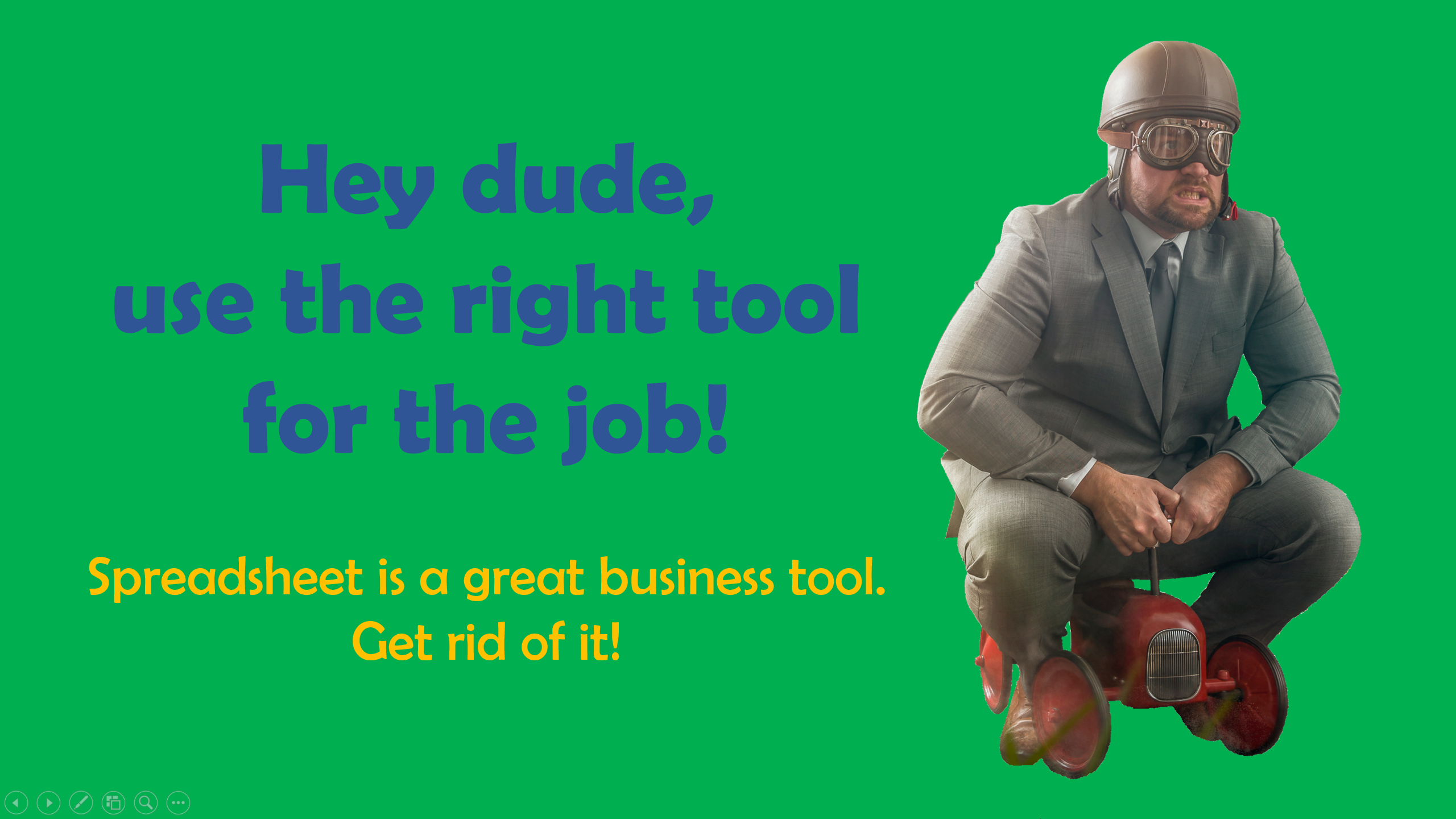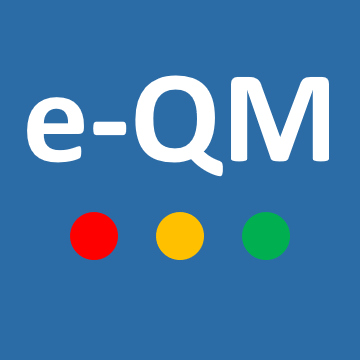
Would you mow your lawn with scissors just because you can, or would you buy a lawnmower?
The idea of that post came with one prospect asking me: “What is the point to go for your solution when we have a spreadsheet?” Fair question indeed.
We are on a mission to offer a solution for eliminating issues, answering questions and getting a perspective. Our tool includes our many year experience and expertise.
We would have been delighted to create it with a spreadsheet. The reality is that, among all the issues, the spreadsheet itself is one of the biggest ones.
Why spreadsheet is overtaken by cloud-based purpose-built application
We all love the ubiquitous spreadsheet application, myself included. All its functionalities make you believe it is all what you need to run your activity. In fact, it revolutionized the way we do business. As the same time, it paved the way to much more powerful and purpose-built solutions. Spreadsheet did not keep up. It cannot be anymore your main central tool. It hampers – not to say it harms – your development. Here below are several majors topics where spreadsheets don’t meet the expectations.
Spreadsheet is not a database
Furthermore, there are limitations to how many rows and columns i.e. to how much data can be handled in one spreadsheet. So it cannot deal with the huge amount of data your business both requires and generates.
It prevents from completing all the tasks and from making data analysis in a fast and comprehensive way.
Like an UFO among today’s applications
Spreadsheet is unlikely interfaced. It leaves its own life with data separated from the other systems in place to run your company. How to use and integrate this data? How to check its consistency?
Spreadsheet is not automatically updated. What about debug or security upgrades?
Limited user interface
Spreadsheet forces yourself to work in tabular form. Specifications or whatever other file can hardly be attached.
The more information you put in, the less visibility you get.
Obstruction to collaboration
Only the most recent versions allow multiple users to work together in one document at the same time. Of course, it works only when your files are cloud-based – most of the time, they are not.
No user profile based access management
Everybody tells you sharing data is a must. That requires data – and functionality – access management. Would you afford the time to create specific copies for each profile of addressees? It is far too much time consuming. There is especially the risk for mixing up data disclosure between the copies. As a result, you could miss your initial target.
No easy workflow management
When it comes to follow-up, information or validation workflow, spreadsheet makes you struggle keeping track. No automatic record of who did input what and when. No e-mail notification process within or outside your organization for validation request, status change, decision, comment, overdue, upload, report, dashboard… Nonstop e-mailing of spreadsheets does not make sense.
Development
No need any more to put together the right formulas.
Did you say macro (by the way, some users are disturbed by the security warning about enabling macro) or Visual Basic? Coding is actually a job for professional developers. If doing it on your own, you risk to reinvent the wheel. In any case, you are unlikely to get all the benefits from a spreadsheet as you would with a purpose-built solution.
And don’t be upset the day when you get stuck because your Visual Basic wizard is gone for some new projects – taking away the secret of his coding. Don’t look for the documentation, there is not.
A big room for errors
We know that one wrong cell or one incorrect input can ruin the entire spreadsheet.
The fact is that, first, almost all spreadsheets contain mistakes. Second, the more you rely on manual processes, the more you get incorrect and false data. You need to deal with the risks and the impact can be painfully expensive. It makes sense to pay a little more attention to the tool you are using.
No way to avoid multiple versions
Low safety features make very easy to manipulate any spreadsheet. When many people are supposed to use a same “corporate” file, you can be sure it turns to be not standard anymore in a very short period of time. By the way, do you remember who keeps the copy of the “master” spreadsheet? Who keeps a back-up of it?… Does it include the last macro you spent hours reconfiguring last week?
In the end, you cannot make sure to keep a pre-defined format. It is easy to close a file without saving the changes. It is easy to not duplicate files. It puts your business at risk for losing information and time between different files.
Lack of security
In most cases, spreadsheets are not password protected. There is no automatic lock. It is enough to access your computer to also access your business data. A hacker or an employee just needs to make a “sent to” or a “save as” to take all your information away. That is shockingly easy! Cloud-based solutions offer encrypted communication and storage with also strong access policy.
General application has low global impact
There is no spreadsheet coming together with a “packaging value-added services” option. Today, solutions are designed by people who understand the details of your activity.
It is one centralized, shared and interactive way of proceeding. It reflects your vision of how to drive the business. Roll-out reaches all involved persons all over your organization.
Reporting
Your boss or your client requests information in a minute? The data should be available in real-time dashboard for real-time monitoring in the cloud.
Moreover, don’t spend hours creating reports. Modern solutions let you compile data much faster. Do tailor-made automatic consolidation. Share within the format you need anytime, anywhere, any device.
Support
Up-to-date solutions are available against a monthly subscription. It includes upgrades, server upkeep, continuous data backup and also online support. Dedicated persons – reachable via online ticketing, mail, phone, are committed to answering questions and fixing bugs if any and listening to your feedback. That last point is of the greatest importance for further improvement and development: new functionalities, better design… to meet your expectations. Updates and upgrades are released on a regular basis.
CONCLUSION
Stop spending your and your teams’ time manipulating data with import, export and other macro and formulas. Instead, you better focus on what data is telling you about your business and the best way to move it forward.
Would you mow your lawn with scissors just because you can, or would you buy a lawnmower?
Spreadsheet will not disappear. It will merely remain as an auxiliary tool. The point is about looking forward and using the right tool for the job!
Cloud-based solutions are more effective with purpose-built functionalities and automated processes. They rely on robust coding and state-of-the-art IT infrastructure for outstanding security and back-up capabilities. They go with devoted support team and without any long training because very intuitive. They foster collaboration and boost your performance. Last but not least, they are flexible and scalable.
Your packaging value-added services activity includes:
– Managing many modus operandi, bills of material and the associated processes whatever they are manual, automatic or semi-automatic,
– Frequent price calculation linked to changes such as an update, a new equipment, a product change, a new technology,
– Regular global benchmark, request for quotation,
– Organization and optimization of a multi-country network of production sites,
– In-house or sub-contracted.
Check out the e-Quotation Models, a ground breaking Continuous Improvement solution based on your quotation process.
e-Quotation Models – Smart Vision, Great Impact
